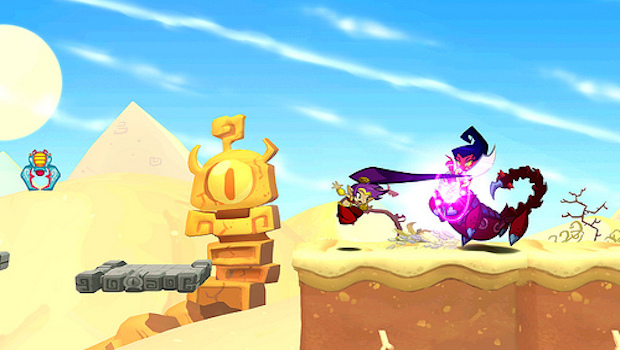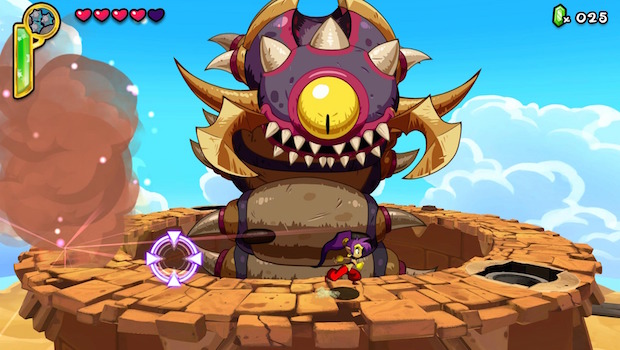Shantae was a series conceived almost 15 years ago by husband and wife duo Matt and Erin Bozon. Erin designed Shantae herself, and Wayforward Technologies, with Matt at the helm, designed the first game which released on the Gameboy Color in 2002. Unfortunately, this title sold poorly due to its release in the golden years of the Gameboy Color (by this point the Gameboy Advance had already been out for a year). Despite the poor sales, it was a critical and cult success, with Shantae becoming Wayforward’s mascot of sorts. After a series of licensed titles (nearly 18 over a period of 8 years), the studio finally got to make a sequel to Shantae in 2010. It was around this time that the team at Wayforward splintered as ex-Wayforward employees left to form Yacht Club game responsible for Shovel Knight. Despite that several Shantae titles have been released since then. This brings us to Shantae: Half-Genie Hero, which was released at the tail end of this year thanks in part to a Kickstater campaign that started back in 2013. It’s an understatement to say that crowd funded games do not have the best reputation, with some never getting released at all and others lacking in quality (Mighty Number 9) but for the most part Shantae is a solid product, with a couple of flaws.
For those who have not played the series before, the games center around Shantae (a half-genie/belly dancer) and her quest to protect Sequin Land and Scuttle Town from a catalogue of barons and pirates (namely Risky Boots, Queen of the Seven Seas). Like most of the games in the series, Half-Genie Hero starts off with the main character getting fired from her job. However, unlike the previous two games in the series, this game does not have any ties to previous entries. This is different from Risky’s Revenge and the Pirate’s Curse which built on top of each other and offered a more compelling narrative. This entry plays out more like a Saturday morning cartoon with a general objective getting derailed by several side tangents. However, in order to access these tangents, the player has to embark on mini-trade quest similar to the Quest for Biggron’s Sword in the Legend of Zelda: Ocarina of Time. This leads to some humorous situations (like getting a foxy grandma hat in exchange for a vorpal blade soaked in the tears of a newborn) but it breaks up the game so that it doesn’t flow as smoothly as previous entries.
At its heart Shantae: Half-Genie Hero is a platformer, taking heavy inspiration from Metroidvania titles and the old Ducktales games. The Castlevania influence is particularly strong when Shantae’s main attack (hair whipping) and other magical abilities are used countless times throughout the game. Progression is achieved via completing stages and finding new animal forms/abilities from the environment. Monetary currency is also collected which can be used to upgrade certain attacks, like making your hair whip faster. In all the game has roughly six stages ranging from a town besieged by pirates to a level that takes place almost exclusively on flying carpets and battleships. However, much of the game feels inadvertently ripped from prior Wayforward games, include entries in the series and even the Ducktales remake. For example, every stage besides the airborne one is something I have treaded through multiple times. In particular, the Haunted Castle and Volcano levels seem right out of the Ducktales remaster.
Unlike previous entries in the series, this title backs away from the Metroidvania style by getting rid of the Overworld map. By doing this, however, it makes finding collectibles even harder than before. This is because you cannot see if there is an unvisited region of the map where a hidden item might reside. In addition, some animal transformation (achieved via belly dancing) are more useful than others. For example, if the monkey form had an attack associated with it, I probably would have played the entire game in that form. Whereas there is a Spider-queen transformation that is only used once or twice throughout the entire game.
Each transformation is adorable thanks to the game’s art style. Which brings us to possibly the defining factor of this game: its visuals. Every one of the game’s characters and enemies is uniquely designed. In addition to that, the background of each stage almost looks like it was taken out of a canvas painting. You can tell that a lot of the Kickstarter budget went into this game’s art design/visuals and, for the most part, they do not disappoint. A few characters look a little weird compared to previous entries (the old man that saves your game for example), but all and all the characters look amazing. The audio from the game is not quite as good as the soundtrack from Shantae and the Pirate’s Curse. Although they got Shantae’s voice actress to sing the opening, the sound track started to grate on me after I revisited a certain stage for the umpteenth time. A lot of this might have to do with the fact that the OST for Pirate’s Curse is twice as long as its successor. That’s not to say quantity over quality is not always better, but diversity can do wonders for a game’s soundtrack.
Despite my gripes with environment and the narrative, Half Genie Hero is all and all a pretty decent platformer. Depending on whether you are going for a 100% completion rate, the game will take you roughly 6-9 hours. After completing the game, you are introduced to hero mode which allows you to play through the game with most of your core abilities unlocked. If you are going for the 1000 achievement points or the platinum you’re in for a 10-15 Hour experience. That said at $20-30 bucks I think most people that have played these games should wait until it drops in price before picking this one up. If you haven’t had the pleasure of playing these games however, I would highly recommend playing its predecessor Shantae and the Pirate’s Curse to see if the series is for you, especially if you are a fan of Metroid and post Symphony of the Night Castlevania games.


